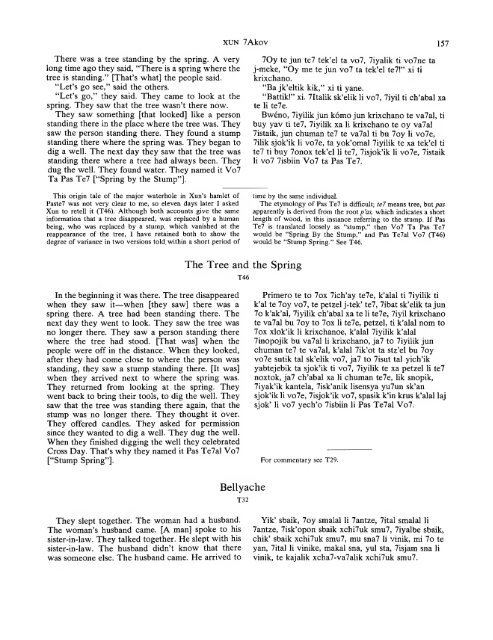PDF (Lo-Res) - Smithsonian Institution Libraries
PDF (Lo-Res) - Smithsonian Institution Libraries
PDF (Lo-Res) - Smithsonian Institution Libraries
Create successful ePaper yourself
Turn your PDF publications into a flip-book with our unique Google optimized e-Paper software.
There was a tree standing by the spring. A very<br />
long time ago they said, "There is a spring where the<br />
tree is standing." [That's what] the people said.<br />
"Let's go see," said the others.<br />
"Let's go," they said. They came to look at the<br />
spring. They saw that the tree wasn't there now.<br />
They saw something [that looked] like a person<br />
standing there in the place where the tree was. They<br />
saw the person standing there. They found a stump<br />
standing there where the spring was. They began to<br />
dig a well. The next day they saw that the tree was<br />
standing there where a tree had always been. They<br />
dug the well. They found water. They named it Vo7<br />
Ta Pas Te7 ["Spring by the Stump"].<br />
This origin tale of the major waterhole in Xun's hamlet of<br />
Paste7 was not very clear to me, so eleven days later I asked<br />
Xun to retell it (T46). Although both accounts give the same<br />
information that a tree disappeared, was replaced by a human<br />
being, who was replaced by a stump, which vanished at the<br />
reappearance of the tree, I have retained both to show the<br />
degree of variance in two versions told, within a short period of<br />
In the beginning it was there. The tree disappeared<br />
when they saw it—when [they saw] there was a<br />
spring there. A tree had been standing there. The<br />
next day they went to look. They saw the tree was<br />
no longer there. They saw a person standing there<br />
where the tree had stood. [That was] when the<br />
people were off in the distance. When they looked,<br />
after they had come close to where the person was<br />
standing, they saw a stump standing there. [It was]<br />
when they arrived next to where the spring was.<br />
They returned from looking at the spring. They<br />
went back to bring their tools, to dig the well. They<br />
saw that the tree was standing there again, that the<br />
stump was no longer there. They thought it over.<br />
They offered candles. They asked for permission<br />
since they wanted to dig a well. They dug the well.<br />
When they finished digging the well they celebrated<br />
Cross Day. That's why they named it Pas Te7al Vo7<br />
["Stump Spring"].<br />
XUN 7Akov 157<br />
The Tree and the Spring<br />
T46<br />
Bellyache<br />
They slept together. The woman had a husband.<br />
The woman's husband came. [A man] spoke to his<br />
sister-in-law. They talked together. He slept with his<br />
sister-in-law. The husband didn't know that there<br />
was someone else. The husband came. He arrived to<br />
T32<br />
7Oy te jun te7 tek'el ta vo7, 7iyalik ti vo7ne ta<br />
j-meke, "Oy me te jun vo7 ta tek'el te7!" xi ti<br />
krixchano.<br />
"Ba jk'eltik kik," xi ti yane.<br />
"Battik!" xi. 7Italik sk'elik li vo7, 7iyil ti ch'abal xa<br />
te li te7e.<br />
Bweno, 7iyilik jun komo jun krixchano te va7al, ti<br />
buy yav ti te7, 7iyilik xa li krixchano te oy va7al<br />
7istaik, jun chuman te7 te va7al ti bu 7oy li vo7e,<br />
7ilik sjok'ik li vo7e, ta yok'omal 7iyilik te xa tek'el ti<br />
te7 ti buy 7onox tek'el li te7, 7isjok'ik li vo7e, 7istaik<br />
li vo7 7isbiin Vo7 ta Pas Te7.<br />
time by the same individual.<br />
The etymology of Pas Te7 is difficult; te7 means tree, but pas<br />
apparently is derived from the root p'as, which indicates a short<br />
length of wood, in this instance referring to the stump. If Pas<br />
Te7 is translated loosely as "stump," then Vo7 Ta Pas Te7<br />
would be "Spring By the Stump," and Pas Te7al Vo7 (T46)<br />
would be "Stump Spring." See T46.<br />
Primero te to 7ox 7ich'ay te7e, k'alal ti 7iyilik ti<br />
k'al te 7oy vo7, te petzel j-tek' te7, 7ibat sk'elik ta jun<br />
7o k'ak'al, 7iyilik ch'abal xa te li te7e, 7iyil krixchano<br />
te va7al bu 7oy to 7ox li te7e, petzel, ti k'alal nom to<br />
7ox xlok'ik li krixchanoe, k'alal 7iyilik k'alal<br />
7inopojik bu va7al li krixchano, ja7 to 7iyilik jun<br />
chuman te7 te va7al, k'alal 7ik'ot ta stz'el bu 7oy<br />
vo7e sutik tal sk'elik vo7, ja7 to 7isut tal yich'ik<br />
yabtejebik ta sjok'ik ti vo7, 7iyilik te xa petzel li te7<br />
noxtok, ja7 ch'abal xa li chuman te7e, lik snopik,<br />
7iyak'ik kantela, 7isk'anik lisensya yu7un sk'an<br />
sjok'ik li vo7e, 7isjok'ik vo7, spasik k'in krus k'alal laj<br />
sjok' li vo7 yech'o 7isbiin li Pas Te7al Vo7.<br />
For commentary see T29.<br />
Yik' sbaik, 7oy smalal li 7antze, 7ital smalal li<br />
7antze, 7isk'opon sbaik xchi7uk smu7, 7iyalbe sbaik,<br />
chik' sbaik xchi7uk smu7, mu sna7 li vinik, mi 7o te<br />
yan, 7ital li vinike, makal sna, yul sta, 7isjam sna li<br />
vinik, te kajalik xcha7-va7alik xchi7uk smu7.

















